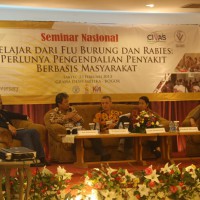Babirusa Population Under Pressure
Wednesday, 30 March 2011
Gorontalo – The population of babirusa, an endemic animal of Sulawesi, in Nantu Forest Reserve in Gorontalo province, is suffering under pressure. The population has declined from an estimate of 500 babirusas in the 1980s to only around 200 animals in 2010. Babirusa meat trade and forest encroachment are believed to be the main causes.
Dr. Lynn Clayton, a conservation researcher from the Adudu Nantu International Foundation (YANI), said even though Nantu forest is said to be a reserve, that doesn’t mean the animals inside it are safe.
“In the 1980s, around 15 babirusas were sold every week in the animal market in Minahasa, North Sulawesi. Now, only 2 or 3 babirusas are traded each week,” said Lynn in Gorontalo on Tuesday (29/3).
Lynn said that law enforcement on animal poaching or encroachment in Nantu Forest Reserve is very weak. The police force is insufficient in number to guard the whole reserve area, which is about 31,000 hectares. There are 6 police on patrol every day.
James Kumolontang, a YANI field staff, said babirusa meat is sold in Minahasa traditional markets for Rp 25,000 to Rp 30,000 a kilogram. In the 1980s, live babirusas were priced Rp 15,000 an animal.
“Besides animal markets, some babirusas are also sold directly to restaurants in Minahasa,” said James, who was a former hunter.
Head of the Environment Division of the Environment, Research, and Information Technology Center of Gorontalo Province, Rugaya Biki, said forest reserves in Gorontalo are under constant pressure from forest encroachment, illegal logging, nomadic agriculture fields, and illegal gold mining.
Sumatran Tigers
In Sumatra, the population of Sumatran tigers is also under constant threat from forest encroachment. Human-tiger conflict is a frequent occurrence.
Head of the Natural Resources Conservation Agency (BKSDA) for Bengkulu, Amon Zamora, said each tiger has its own home range. Forest encroachers often trespass into those home ranges. “It is either the human attacked or the tiger killed,” Amon said.
So far in 2011, there were 3 cases of human-tiger conflict in Bengkulu. The cases occurred in Seluma, Mukomuko, and Bengkulu Utara districts. Of all three cases, only the tiger in Seluma was captured using a trap. The tigers in Mukomuko and Bengkulu Utara were repelled back into the forest.
In Kerinci, Forest Ecosystem Control (PEH) of Kerinci Seblat National Park (KSNP), Iding Ahmad Haidir, said based on survey in 2006 – 2008 which was then repeated in 2009 – 2010, there are around 140 adult Sumatran tigers in KSNP.
KSNP has an area of 1.4 million hectares, spanned across West Sumatra, Jambi, Bengkulu, and South Sumatra. So far, prey for tigers is still available, particularly wild pigs.
The availability of prey animals, such as wild pigs and deer, allows the tiger population to regenerate well. As evidence, said Iding, new individuals were identified in the border areas of Merangin-Kerinci, Jambi and Ipuh, in Mukomuko district, Bengkulu. (APO/ADH)
Source : Kompas






